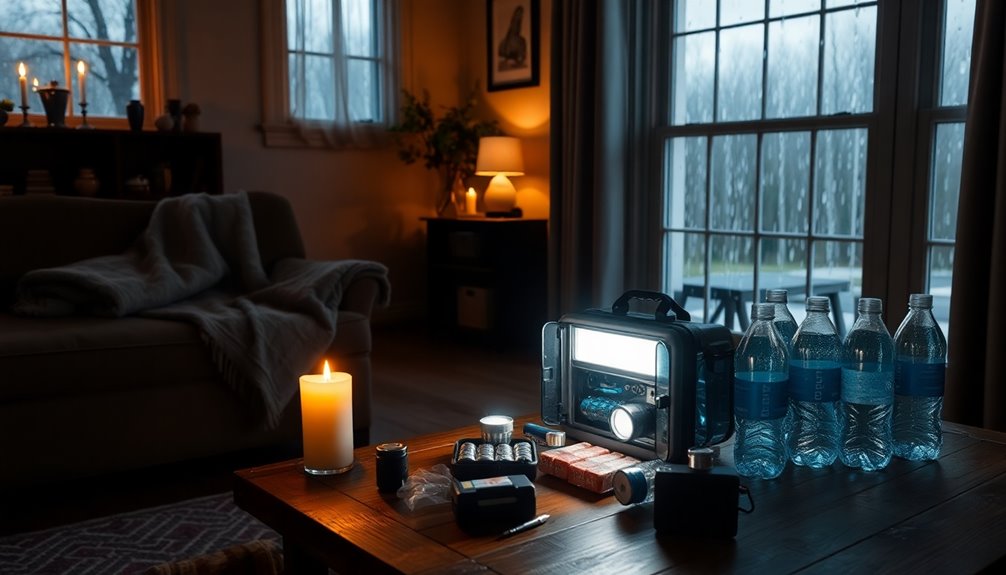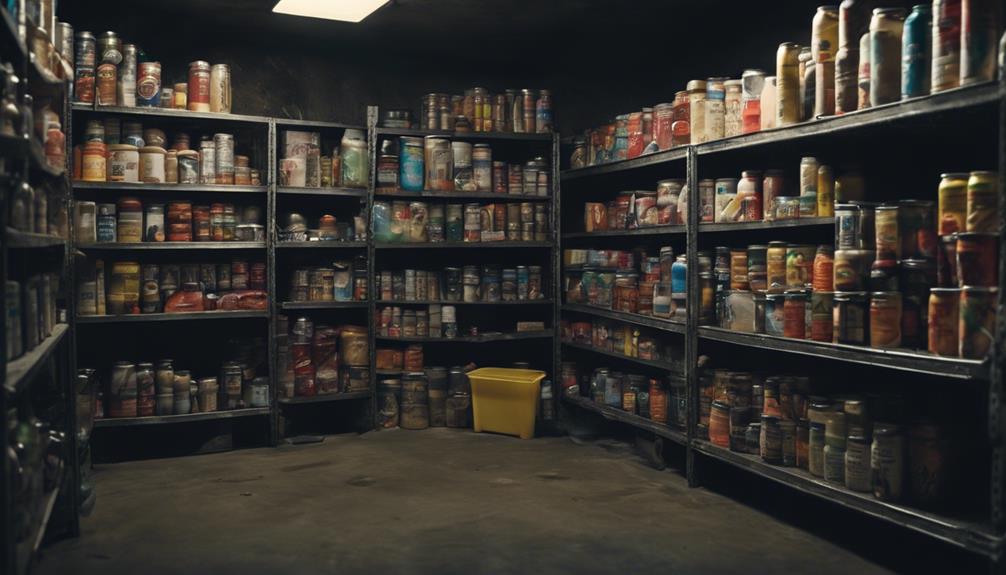In a power outage, staying calm is vital. First, assess the situation and report the outage. Keep your refrigerator closed to preserve food safety. If you're prepared, you'll have an emergency kit stocked with flashlights, batteries, water, and nonperishable food. Remember to use a battery-powered radio for updates and keep a safe generator outdoors, if needed. Manage food temperatures and discard spoiled items. If you plan ahead and maintain your supplies, you can navigate the outage smoothly. To explore tips on essential supplies and safety measures, you'll want to check out more details on being properly prepared.
Key Takeaways
- Stay calm and assess the situation by checking for any visible damage and reporting the outage to the utility company.
- Preserve food safety by keeping refrigerator and freezer doors closed to maintain temperature.
- Use flashlights and battery-powered lanterns for lighting, avoiding candles to prevent fire hazards.
- Activate emergency generators if necessary, ensuring they are placed outdoors and away from windows.
- Stay informed through battery-powered radios or social media for updates on the outage and restoration efforts.
Preparing for a Power Outage
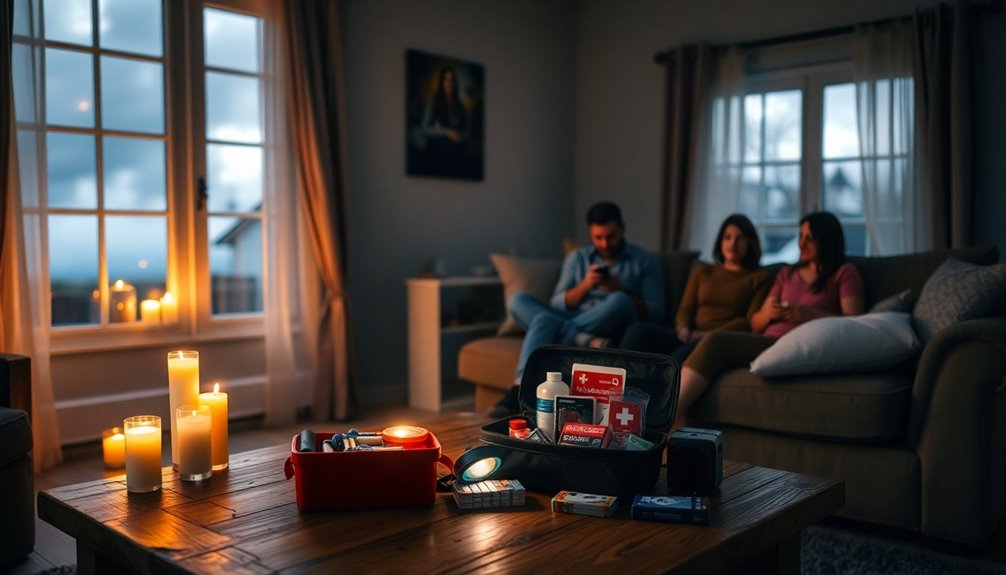
When preparing for a power outage, it's essential to take proactive steps to guarantee your safety and comfort. Start by registering any life-sustaining medical equipment with your utility company. This assures they're aware of your needs during outages. If you have a generator, make certain it's installed by a licensed electrician and always keep it outside for proper ventilation.
You should also have a safe alternative heat source ready, along with fuel for it. Remember, never use charcoal, gas ovens, or propane heaters indoors. Familiarize yourself with how to manually open electric garage doors, just in case. Plus, fill up your vehicle's fuel tank in case you need to evacuate. Additionally, consider assembling an emergency supply container that includes essential items such as flashlights, batteries, and a first aid kit.
Develop an emergency plan for your household, including an exit strategy. Keep important contact numbers handy, like your utility company's emergency line. Confirm your mobile phones are charged and consider a portable charger. Finally, have a corded telephone available since cordless phones won't work without power. By taking these steps, you'll greatly enhance your readiness for any power outage.
Essential Supplies for Your Kit
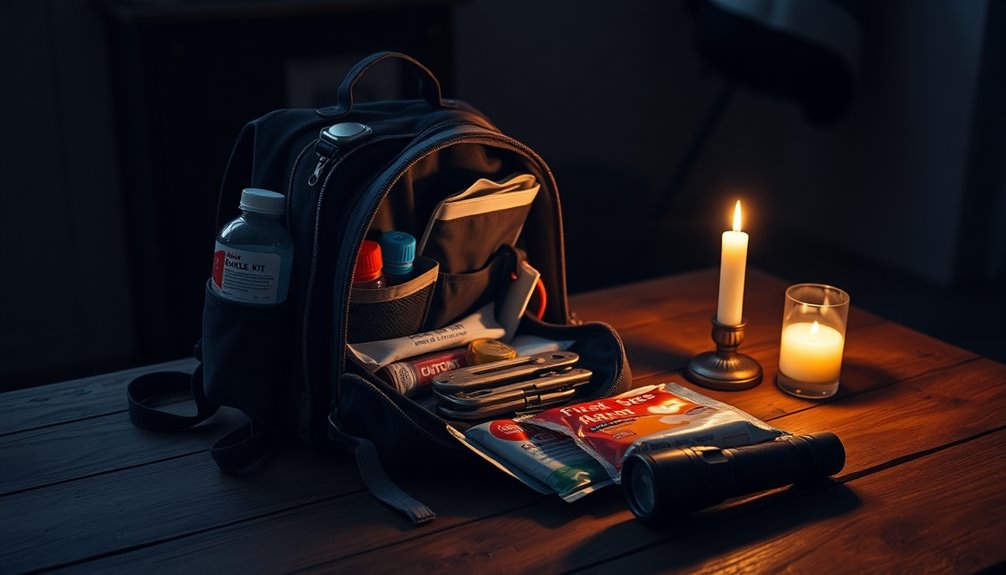
A well-stocked emergency kit can make all the difference during a power outage. Start with lighting solutions; include flashlights with extra batteries, battery-powered lanterns, and glow sticks. For safety, consider candles and matches, but use them with caution. Hand-crank or solar-powered flashlights are also great alternatives.
Next, focus on food and water supplies. Store at least one gallon of bottled water per person per day for three days. Don't forget a manual can opener and a selection of nonperishable food items like canned goods, dried foods, and energy bars. Water purification tablets or filters will guarantee you stay hydrated, and if you have pets, include non-perishable pet food. Having enough water supplies ensures you remain hydrated and healthy during an outage.
Communication is vital, so pack a battery-powered or hand-crank radio, ideally a NOAA Weather Radio. Portable chargers or power banks for your mobile devices and extra batteries or charging cables are indispensable.
Lastly, gather essential personal items: prescription medications, hygiene products, a first aid kit, personal identification, and blankets for warmth. Being prepared with these supplies will help you navigate the challenges of a power outage effectively.
Actions During an Outage
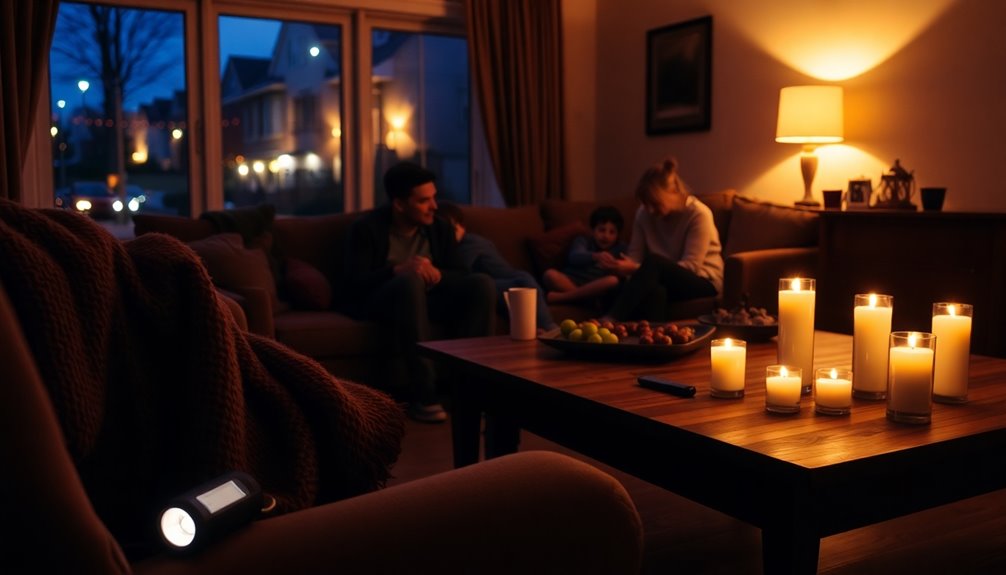
When the power goes out, your first step is to assess the outage's scope. Check if nearby homes are affected and report the situation to your utility company with relevant details. It's also essential to preserve food safety by keeping your refrigerator and freezer closed as much as possible. Being prepared with an emergency response plan can significantly reduce downtime and enhance your resilience during such outages.
Assess Outage Scope
During a power outage, it's crucial to quickly assess the scope of the situation. Start by identifying the affected area and the number of people impacted. If possible, determine the cause of the outage and check if neighboring areas are also experiencing issues. Look for any visible infrastructure damage, like downed wires or blocked roads, as this can affect safety and response efforts. It's important to remember that downed wires should be reported immediately for safety. Additionally, ensure that air quality is monitored, as prolonged outages can lead to the accumulation of indoor pollutants.
Once you've gathered this information, report the outage to your electric utility company or local emergency management agency. You can usually reach them via text, online, or by calling designated numbers. If you're in an organization, inform relevant stakeholders as well.
Safety is paramount, so help anyone in darkened areas move to safety, and check elevators to verify no one’s trapped. Secure sensitive data and shut down non-essential systems to prevent damage. Clear roads of electrical hazards and activate emergency generators for critical systems. Provide guidance to individuals on evacuation routes and emergency assembly points. Ensure that emergency evacuation tips are communicated clearly through public address systems and other communication channels. Additionally, designate and train a team of personnel to assist with the safe evacuation of all individuals in the event of an emergency. Identify and deploy first aid teams to provide medical assistance as needed and communicate with emergency response personnel. Make sure that all emergency exits are clearly marked and easily accessible, and establish a system for accounting for all individuals once they have evacuated. It is important to emphasize the importance of not attracting attention in an emergency, as this can help prevent panic and chaos. Properly trained and equipped personnel should be assigned to manage crowd control and ensure that everyone remains calm and follows evacuation procedures.
Preserve Food Safety
Power outages can often catch you off guard, but taking quick action to preserve food safety is crucial. Keep your refrigerator and freezer doors closed as much as possible to maintain cold temperatures. If you've prepared in advance, use frozen water containers or gel packs to help keep temperatures low. Monitor food temperature; refrigerated food is safe for about 4 hours if the door stays closed, while a full freezer can maintain temperature for up to 48 hours.
If the outage lasts longer, consider transferring perishables to a cooler with ice to keep them at 40°F or below. Always check food for spoilage signs like off smells or unusual textures—never taste food to determine its safety. Perishables like meat and dairy should be discarded if they've been above 40°F for over two hours. If you find thawed food still contains ice crystals or is at 40°F or below, you can safely refreeze or cook it. Additionally, regular use of air purifiers can help improve overall indoor air quality, making your home safer while you handle the power outage. Finally, remember the two-hour rule for any perishable items left at room temperature to guarantee you're keeping your food safe during the outage. Additionally, having ice or dry ice available can significantly extend the safe storage time for your food during prolonged outages.
Managing Food Safety

Managing Food Safety
Preparing for a power outage involves guaranteeing your food stays safe to eat. Start by keeping your refrigerator at 40°F or below and your freezer at 0°F or lower. Use appliance thermometers to monitor these temperatures. Before an outage, freeze containers of water and gel packs to help keep your food cold. It's also wise to have dry ice or block ice on hand for longer outages, along with a cooler and frozen gel packs.
During the outage, keep refrigerator and freezer doors closed as much as possible. Group packages of cold food together to minimize heat gain. If needed, use coolers with ice to maintain perishable foods at 40°F or below. Monitor food temperatures every four hours and avoid cooking if you can't maintain safe internal temperatures. Potentially Hazardous Foods must be discarded after four hours without power to prevent illness.
After four hours without power, discard perishable foods like meat, fish, eggs, milk, and leftovers. Check for spoilage signs and use a thermometer to guarantee food stays below 40°F. If thawed frozen food contains ice crystals or is at 40°F or below, you can refreeze or cook it. Remember, when in doubt, throw it out—never taste food to check safety.
Using Generators Safely
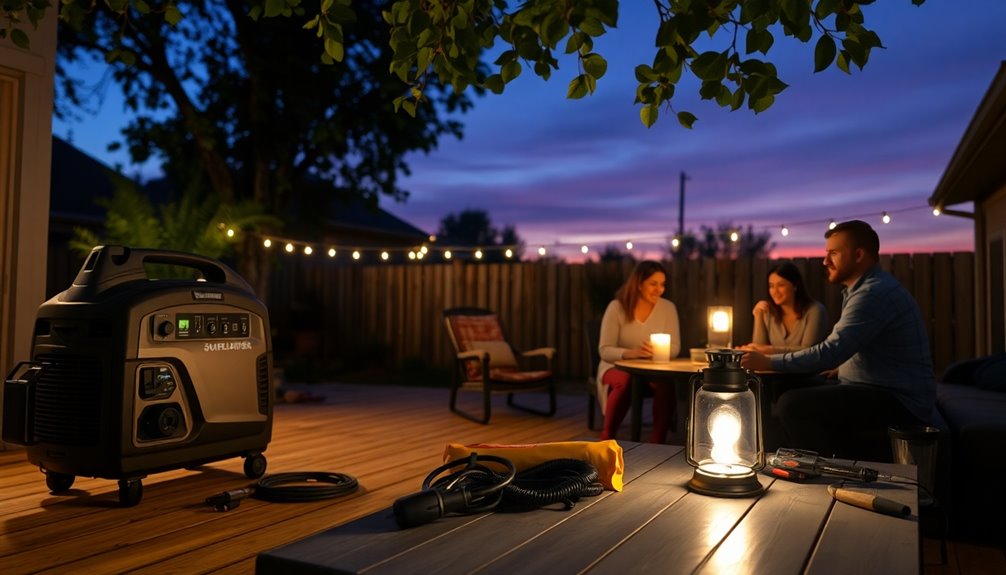
When using a generator, it's essential to place it outdoors in a well-ventilated area, away from windows and doors. Following safe operation practices not only protects you but also guarantees your generator runs efficiently. Remember, safety first—proper placement and operation can prevent dangerous situations like carbon monoxide poisoning. Additionally, avoid overloading the generator by using it only for essential equipment to ensure safe and effective operation.
Generator Placement Guidelines
Proper generator placement is essential for both safety and efficiency during a power outage. To guarantee you're setting up your generator correctly, follow these guidelines:
- Distance Matters: Keep your generator at least 1.5 feet away from any structure and 5 feet from doors or windows. This helps prevent harmful exhaust fumes from entering your home.
- Choose the Right Spot: Select a location with stable, well-draining soil. Avoid placing the generator near water sources or areas prone to flooding. Additionally, ensure that the generator is installed on a flat, stable surface to prevent shifting and ensure proper function.
- Consider the Elements: Protect your generator from extreme temperatures by guaranteeing it has adequate airflow in hot weather and using insulation in cold conditions.
- Check Local Regulations: Before installation, consult local codes and obtain any necessary permits. Make sure to follow National Fire Protection Association (NFPA) guidelines to avoid fines or relocation issues.
Safe Operation Practices
Using a generator safely during a power outage is essential to protect yourself and your home. Follow these key practices to guarantee safe operation:
| Safety Concern | Best Practices | Notes |
|---|---|---|
| Electrical Safety | Never connect directly to home wiring. | Use a transfer switch for permanent setups. |
| Carbon Monoxide | Operate outside, away from doors and windows. | Install battery-powered CO alarms. |
| Fire and Fuel Safety | Store fuel safely in labeled containers. | Turn off generator before refueling. |
| General Operational | Read manufacturer instructions carefully. | Keep children and pets away. |
Always use heavy-duty extension cords rated for outdoor use and avoid overloading your generator by prioritizing essential appliances. Remember, never use a generator indoors or in enclosed spaces due to the risk of carbon monoxide poisoning. Ensuring proper generator maintenance is crucial for safe operation and reliability. Qualified electricians must be consulted for proper generator installation to ensure safety. Be aware of symptoms like dizziness; seek fresh air immediately if you experience them. Keeping your generator well-maintained and following these safety practices can prevent accidents and guarantee that you have a reliable power source during outages. Stay safe and prepared!
Alternative Lighting Options

In a power outage, having reliable alternative lighting options can make all the difference in maintaining safety and comfort. You'll want to ascertain you have various light sources ready to go, so you can navigate your home easily and avoid accidents.
Here are four effective lighting options to ponder:
- Flashlights: Portable and easy to use, they can be battery-operated or hand-cranked, assuring you have light when you need it. Additionally, it's important to regularly check batteries to ensure functionality during outages.
- Battery-Operated Lanterns: These provide 360-degree light and adjustable brightness, making them great for illuminating larger areas.
- Candles: While inexpensive and easily accessible, they pose a fire hazard, so use them cautiously and avoid leaving them unattended.
- Solar Lamps: Perfect for short-term outages, these charge during the day and provide light at night. Some models even charge your mobile devices.
Staying Informed and Connected

When the lights go out, staying informed becomes just as important as having a reliable light source. You can use various tools to keep up with developments during a power outage. Consider investing in a CB radio; it requires no special license and can be powered by your vehicle or a solar charger. If you prefer something more portable, a handheld emergency radio might be ideal. These devices can be hand-cranked for power and allow you to listen to local news updates.
For more extensive communication, satellite phones offer global coverage, though they come with higher costs. The Garmin inReach Mini is another excellent option, providing two-way communication and SOS capabilities, perfect for emergencies. Understanding the importance of establishing trusted communication channels will help mitigate misinformation and panic during outages.
Don't overlook social media; platforms like Facebook and Twitter are great for real-time updates. Share information across multiple channels, including email and text, to guarantee you stay connected. Finally, establish a centralized communication plan with your family and neighbors, so everyone knows where to find reliable information and updates. Being proactive in your communication will help you stay informed and make the best decisions during an outage.
After the Power Restores

Once the power is restored, it's crucial to verify that everything is functioning properly and safely. Start by checking the power supply in your home and confirming all appliances are working as they should. Here's a quick checklist to help guide you:
- Inspect Main Power Lines: Look for any visible damage or hazards in the main distribution lines near your home. Verify everything looks intact and safe.
- Check Essential Services: Confirm that critical facilities, like hospitals and emergency services, have power. This guarantees your community is safe and operational. Service reliability typically stands at 99.98% under normal conditions, so most issues should be resolved quickly. Additionally, it's beneficial to know that energy-efficient technology can help reduce power consumption in the long run.
- Test Appliances: Gradually turn on appliances to avoid overloading circuits. Pay attention to any unusual sounds or flickering lights, which might indicate issues.
- Stay Updated: Keep an eye on notifications from your power company regarding any remaining outages or service issues. They'll provide valuable information about restoration times or further precautions.
Regular Maintenance and Checks
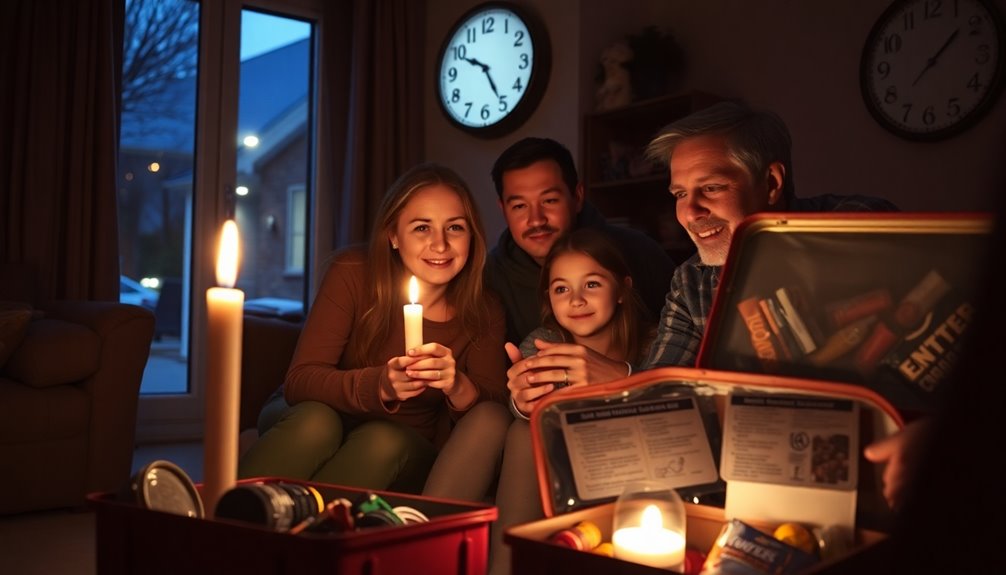
Keeping up with regular maintenance and checks can make a significant difference in preventing power outages and guaranteeing your electrical systems run smoothly. Start by conducting routine assessments of your electrical infrastructure. Regularly check transformers, switches, and other equipment for loose connections, damaged wiring, and any signs of wear and tear. Pay attention to overcrowding or overheating of equipment, and consider using remote monitoring systems for real-time alerts. Additionally, regular inspections are essential to identify potential issues before they escalate.
Don't forget about your backup systems, like UPS and generators. Schedule preventative maintenance to extend their lifespan, test them regularly, and replace any equipment that's reached the end of its life cycle. Always hire experienced, industry-accredited technicians for any maintenance work.
Implement redundancy measures to safeguard against outages. Use various UPS topologies based on your needs and guarantee a seamless changeover during power interruptions. Installing whole home surge protectors can help protect your major appliances.
Lastly, invest in employee training. Regularly train your staff on electrical safety protocols and the proper operation of backup generators. Conduct drills to guarantee everyone is prepared for different outage scenarios, fostering a culture of readiness.
Frequently Asked Questions
How Can I Prevent Food Spoilage During an Extended Power Outage?
To prevent food spoilage during an extended power outage, keep your refrigerator and freezer doors closed as much as possible. Before an outage, prepare by freezing water containers and gel packs, and have a cooler ready. If the power's out for over four hours, transfer perishables to the cooler with ice. Regularly check your food for signs of spoilage, and discard anything questionable to guarantee your safety. Stay proactive to minimize waste!
What Should I Do if My Generator Fails During an Outage?
If your generator fails during an outage, first, turn it off and check for any obvious issues. Don't attempt to restart it immediately; give it some time. Next, report the failure to your electric supply authority. While waiting for help, consider alternative heating and lighting options, and stay informed with a battery-powered radio. If it's cold, layer your clothing or find a friend or family member with power to stay warm.
How Long Can Food Safely Stay in the Refrigerator During an Outage?
Food can stay safely in your refrigerator for up to 4 hours during an outage, but it's essential to keep the doors closed. If the power's out for longer than that, perishable items should be discarded. For outages lasting 2 to 3 hours, most refrigerated foods remain safe if the temperature stays below 40°F. Always check food quality once the power's restored, and when in doubt, it's better to throw it out.
What Are the Risks of Using Multiple Candles for Lighting?
Using multiple candles for lighting can increase risks considerably. They can knock over, they can melt improperly, and they can create a fire hazard if placed too close together. Plus, if you're not careful, you might forget about them, leading to unattended flames. Always keep candles at least 3 inches apart and on stable surfaces. Instead of juggling multiple candles, consider safer alternatives like flashlights or lanterns to light your space.
How Can I Help My Pets During a Power Outage?
During a power outage, you can help your pets by keeping them warm and comfortable. Move them to the center of your home, providing extra bedding and blankets. Make certain they have access to fresh water and monitor their food supply. Keep their routine consistent to reduce stress, and guarantee all exits are secure to prevent escapes. Remember to supervise them outdoors to avoid hazards like downed power lines.
Conclusion
In the quiet darkness of a power outage, it's easy to feel lost and anxious. But with the right preparation, you can transform uncertainty into a sense of security. As you light a candle, remember the warmth it brings, contrasting the chill of the unknown. By staying calm and organized, you're not just surviving; you're thriving. When the lights flicker back on, you'll appreciate their glow even more, reminding you of the strength found in resilience and readiness.

